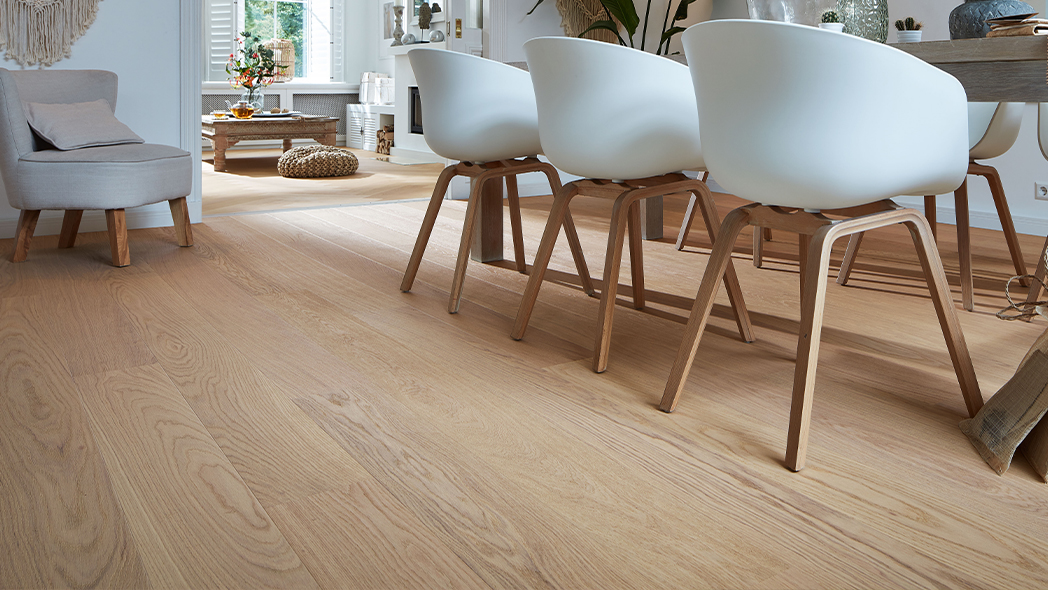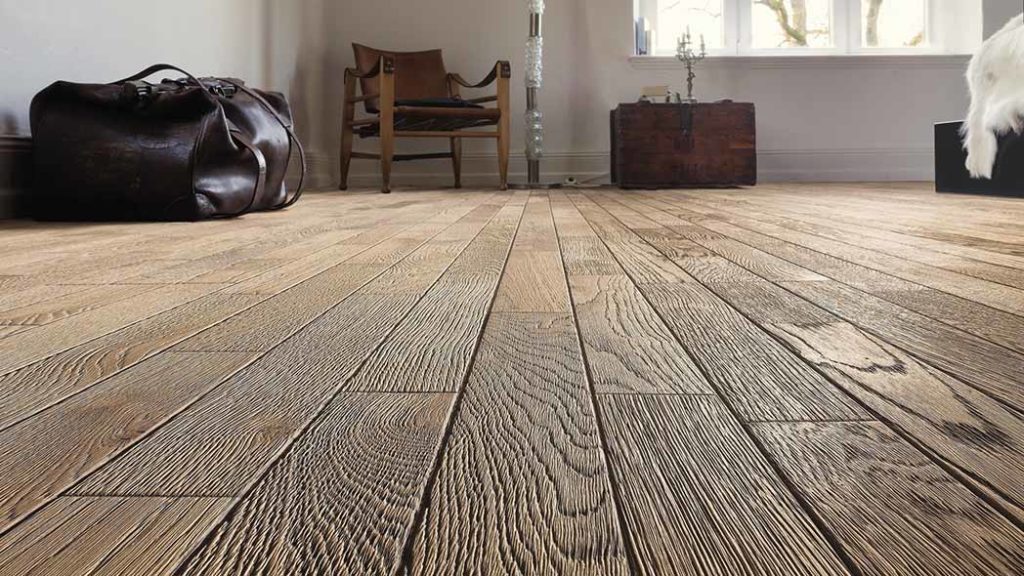
Solid wood flooring has a long tradition and remains one of the most popular floor coverings to this day. And for good reason, as this real wood flooring creates a cosy, warm atmosphere and contributes to a pleasant indoor climate. Moreover, this natural material stands out for its high durability, is easy to maintain, and hygienic. Allergy sufferers particularly appreciate the advantages of solid wood flooring. Thanks to the sealing of hardwood floors, neither dust nor other allergens can settle in the gaps, preventing discomfort from the outset.
Solid wood flooring is also ideal for underfloor heating. The heat-retaining material naturally feels pleasantly warm and provides a high level of walking comfort. One major advantage of hardwood flooring is that it is available in many different colours and variants. This allows you to express your personal taste and perfectly complement your interior design with the choice of wooden flooring.
Content
- 1 What Types of Solid Wood Flooring Are There?
- 2 What is Solid Wood Flooring?
- 3 What is a Natural Wood Floor?
- 4 What is a Wooden Floorboard?
- 5 What is the Difference Between Parquet and Wooden Floorboards?
- 6 What You Need to Know About Solid Wood Flooring
- 7 Experience the best service with planeo - because you need it!
What Types of Solid Wood Flooring Are There?
Wood flooring is not just wood flooring. Instead, there are various types that differ in certain product characteristics and which you should consider when making your selection:
Particularly noble solid wood flooring includes solid wood flooring. There are also different types here that differ in material and construction: so-called strip or mosaic flooring consists of wood laid with a standing grain, glued, and sanded. It is considered particularly robust and is cheaper than other solid wood floors. The classic plank flooring, on the other hand, is made from solid wooden boards and laid with a lying grain. Well-known examples include herringbone flooring and other patterns. Solid wood flooring is primarily made from durable hardwood, particularly beech, oak, and cherry.
Solid wood floorboards have a long tradition. Compared to parquet, the individual boards are very long and often span the entire room. In the past, the boards were nailed to beam ceilings; today, they are laid on a wooden layer on the screed. Traditionally, floorboards are made from softwood such as pine, spruce, Douglas fir, or pitch pine. However, for cost reasons, the floorboards of some manufacturers today are no longer solid, but consist of 2 to 3-layer laminated woods. These solid wood floors are not only cheaper to produce, but they also do not deform as easily.
In addition to the mentioned variants, the floors also differ in their surface structure and surface treatment (finish). The surface structure gives the solid wood floor a unique texture. It can be structured, brushed, hand-planed, sanded, or have a 3D effect. The finish also influences the appearance and determines how to maintain the surfaces. Here, a distinction is made between clear varnished, oiled, light soaped, or dark pigmented solid wood floors.
What is Solid Wood Flooring?
Solid wood floors are floor coverings made from real wood, unlike plastic floors. These include parquet and solid wood floorboards, although some manufacturers differentiate between parquet and solid wood flooring: unlike parquet, the wear layer, that is, the top layer, is less than 2.5 mm for a solid wood floor. So-called veneer floors, on the other hand, consist of an extremely hard, highly compressed wood fibreboard, on which a thin wood veneer is applied. This variant is significantly cheaper and a good alternative for those on a limited budget.
What is a Natural Wood Floor?
In the context of solid wood flooring, the term "natural wood floor" is sometimes mentioned. What this means is not always immediately clear, as there is no precise or uniform definition for it. Often, the term natural wood floor is simply used as a synonym for solid wood flooring, perhaps to emphasize once more that this flooring - unlike plastic - is a natural material. Some manufacturers designate certain product lines as natural wood floors. These are characterized by a specially treated (e.g., oxidatively natural oiled) surface or a particularly rustic appearance.
What is a Wooden Floorboard?
Wooden floorboards are among the oldest types of flooring in existence, with their history dating back several centuries. In the past, wooden floorboards would run across the entire room, and even today, their dimensions are the most striking feature of this type of flooring. With a thickness of up to 36 mm, most floorboards available on the market are 95 to 175 mm wide and several meters long. Depending on the room size and personal taste, narrow or wide boards can create a stunning effect. Due to their rustic look and the cosy-warm atmosphere they create, wooden floorboards have retained their popularity and charm to this day. This is also due to their robustness and longevity. Because of their thick wear layer, they can be sanded down and refinished multiple times if needed.
What is the Difference Between Parquet and Wooden Floorboards?
Parquet and wooden floorboards are both wooden flooring options ("solid wood flooring") and have several similarities: they can either be made of solid wood or consist of multiple layers, with only the top layer being solid wood. The surface of both parquet and wooden floorboards can be treated in various ways and sanded down and refinished if necessary. Both types of flooring are suitable for floating or glued installation. They are available in various designs, making them suitable for different interior styles.
However, there are some differences between parquet and wooden floorboards: the most noticeable at first glance is the size of the individual wooden planks. Parquet flooring consists of many small pieces (strips) that form specific patterns once laid. Popular pattern examples include the ship deck pattern and the herringbone pattern, which can create a distinctive look. A typical installation unit is usually 18 cm wide and 2.20 m long.
Wooden floorboards, on the other hand, can be several meters long. They are laid side by side. Due to their width and length, the typical wood grain is more prominent, and the overall appearance is calmer.

What You Need to Know About Solid Wood Flooring
Are you convinced of the benefits of solid wood flooring and now want to choose a suitable floor? With the following information, your choice will surely be easier, and you will find exactly the solid wood floor that suits you, your home, and your requirements.
What Wood Should Be Used for Wooden Floorboards?
Traditionally, softwoods such as spruce, pine, or larch are used for wooden floorboards. But rustic oak is also becoming increasingly popular for wooden floorboards. The choice of wood ultimately depends on personal taste, as the main differences between wood types lie in their color and grain, as the following overview shows:
• Spruce: light, soft color, light grain
• Pine: light, but slightly more intense color and stronger grain
• Larch: reddish-brown color and distinct grain
• Oak: warm golden-brown (darkens over time) and very pronounced grain
Each type of wood creates a different effect. For example, spruce floorboards offer a calmer appearance, while oak floorboards can look rustic or elegant.
Which Solid Wood Flooring is Durable?
In general, all solid wood floors are very robust and resistant, and with regular use and care, they have a long lifespan. Solid wood floors made from beech or oak are considered particularly durable and resilient, as this wood has a high raw density and can withstand loads from furniture, shoes, or toys well. Wood types such as cherry, spruce, or pine are somewhat more sensitive and are more suitable for rooms with less traffic.
The durability of the wood floor also depends on the thickness of the wear layer. For engineered wood flooring, this is usually 2.5 to 3.5 mm thick, allowing the boards to be sanded down 2-3 times. Solid wood floorboards, on the other hand, can be sanded almost indefinitely and therefore have an almost unlimited lifespan.
The finish can also affect the durability of the floor. Floors with a varnish finish are considered particularly durable, which is why they are often used in commercial areas.
How Much Does Solid Wood Flooring Cost?
The price depends on various factors, such as the type of wood. While pine and spruce are among the more affordable types, beech and oak cost more, and tropical woods require the deepest pockets.
The construction of the flooring also influences the price: generally, engineered wood flooring is somewhat cheaper than solid wood flooring, but given its often much longer lifespan, the initially higher price of solid wood flooring pays off in the long run.
How Do I Clean Solid Wood Flooring?
The basic cleaning is essentially the same for all wooden floors. The rule is: regularly vacuum and remove stains as soon as possible - preferably with a soft cloth and some lukewarm water. Do not use aggressive all-purpose cleaners or microfiber cloths, and only wipe with a slightly damp cloth, as moisture should not penetrate the gaps, otherwise, the wood can swell. Further care depends on the surface of the solid wood floor. The following overview provides guidance on what to consider when wiping the different types of floors:
• Varnished floors: Use clear water or - if necessary - a bit of mild soap.
• Oiled floors: Do not use regular soap, as it would attack the oil film, but use special cleaning agents for oiled surfaces.
• Soaped floors: These floors can be wiped wet and absorb water and care products.
Tip: Save yourself a lot of dirt and thus work by taking off your street shoes outside or placing a doormat in the entrance area where residents and guests can thoroughly wipe their shoes.
Experience the best service with planeo - because you need it!
No matter what challenges you face with your project, planeo provides you with the right solution. Benefit from the advantages of our services:
- Free samples⁴ for many of our products: Order up to 7 samples at no cost, for instance, of our parquet flooring.
- Express delivery² - for urgent projects and quick decisions.
- Expert advice¹ - We offer professional consultation through our contact page or answer your questions directly in the comments.